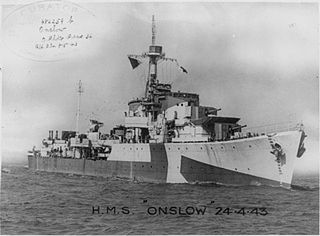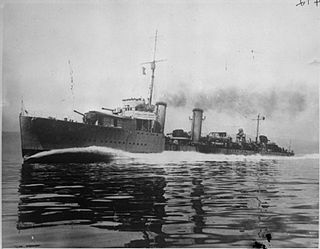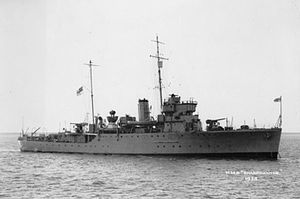
The first HMS Montrose was one of eight Admiralty-type destroyer leaders, sometimes known as the Scott class. They were named after figures from Scottish history; Montrose was named for the Graham Dukes of Montrose. She was built during the First World War, but was completed too late for service then. However, she had a long career in the inter-war years and saw extensive service during the Second World War.

The Halcyon class was a class of 21 oil-fired minesweepers built for the British Royal Navy between 1933 and 1939. They were given traditional small ship names used historically by the Royal Navy and served during World War II.

HMS Halcyon was the lead ship in her class of minesweepers built for the Royal Navy in the 1930s. The vessel was launched on 20 December 1933 and was used as a convoy escort and during the landing operations during the Invasion of Normandy during World War II. The ship was sold for scrapping in 1950.

HMS Onslow was an O-class destroyer of the Royal Navy. The O-class were intermediate destroyers, designed before the outbreak of the Second World War to meet likely demands for large number of destroyers. They had a main gun armament of four 4.7 in guns, and had a design speed of 36 kn. Onslow was ordered on 2 October 1939 and was built by John Brown & Company at their Clydebank, Glasgow shipyard, launching on 31 March 1941 and completing on 8 October 1941.
Convoy PQ 1 was the second of the Arctic Convoys of World War II by which the Western Allies supplied material aid to the Soviet Union in its fight with Nazi Germany. The convoy sailed from Hvalfiord in Iceland on 29 September 1941 and arrived at Archangelsk on 11 October 1941.

HMS Tartar was a Tribal-class destroyer of the Royal Navy that saw service in most of the naval theatres of World War II. She had an eventful career, eventually receiving the nickname 'Lucky Tartar' due to her numerous escapes from dangerous situations. She was one of only four from the sixteen Royal Navy-operated Tribal-class destroyers to survive the war.

HMS Escapade was an E-class destroyer built for the Royal Navy in the early 1930s. Although assigned to the Home Fleet upon completion in 1934, the ship was attached to the Mediterranean Fleet in 1935–1936 during the Abyssinia Crisis. During the Spanish Civil War of 1936–1939 she spent considerable time in Spanish waters, enforcing the arms blockade imposed by Britain and France on both sides of the conflict. Escapade was assigned to convoy escort and anti-submarine patrol duties in the Western Approaches when World War II began in September 1939, but transferred back to the Home Fleet at the end of the year.

HMS Britomart was a Halcyon-class minesweeper of the Royal Navy. She served during the Second World War and was sunk in 1944 in a friendly fire incident. The actor Robert Newton served aboard her until 1943.

HMS Jason was a Halcyon-class minesweeper. She was named after the hero in Greek mythology and was the sixteenth Royal Navy ship to carry the name Jason. She was laid down on 12 December 1936, launched on 6 October 1937, and was completed on 9 June 1938. She survived the Second World War and was sold in 1946 to become a cargo ship. She was eventually broken up in 1950. Her pennant number was originally N99, but was changed to J99 in May 1940.

HMS Keppel was a Thornycroft type flotilla leader built for the Royal Navy at the end of the First World War. She was completed too late to serve in that conflict, but saw extensive service in the inter war years and in World War II. She was an effective convoy escort and U-boat killer, being credited with the destruction of five U-boats during the Battle of the Atlantic. She was the second of three ships named for 18th century Admiral Augustus Keppel.
Convoy PQ 12 was an Arctic convoy sent from Great Britain by the Western Allies to aid the Soviet Union during World War II. It sailed in March 1942, reaching Murmansk despite a sortie against it by the German battleship Tirpitz. All ships arrived safely.

Convoy PQ 8 was an Arctic convoy sent from Great Britain by the Western Allies to aid the Soviet Union during World War II. It sailed in January 1942 and arrived in Murmansk with the loss of one escort sunk, and one ship damaged.

HMS Bramble was a Halcyon-class minesweeper of the British Royal Navy, which was commissioned in 1939, just prior to World War II. During the war she served as a minesweeper in the North Sea, and then on Russian convoys until sunk in the Battle of the Barents Sea on 31 December 1942 by the German cruiser Admiral Hipper and the destroyer Friedrich Eckoldt.

The Arctic Circle defining the "midnight sun" encompasses the Atlantic Ocean from the northern edge of Iceland to the Bering Strait in the Pacific Ocean. Military activity in this area between 1939 and 1945 is often considered part of the Battle of the Atlantic or of the European Theatre of World War II. Pre-war navigation focused on fishing and the international ore-trade from Narvik and Petsamo. Soviet settlements along the coast and rivers of the Barents Sea and Kara Sea relied upon summer coastal shipping for supplies from railheads at Arkhangelsk and Murmansk. The Soviet Union extended the Northern Sea Route past the Taymyr Peninsula to the Bering Strait in 1935.

QP 14 was an Arctic convoy of the QP series which ran during World War II. It was one of a series of convoys run to return Allied ships from Soviet northern ports to home ports in Britain. It sailed in September 1942 from Archangel in Russia to Loch Ewe in Scotland.
Convoy QP 15 was an Arctic convoy of the PQ/QP series which ran during the Second World War. It was one of a series of convoys run to return Allied ships to home ports in the United Kingdom from the northern ports of the Soviet Union. It sailed in November 1942 and was the last convoy in the "QP" series. It was scattered by a storm which sank the Soviet destroyer Sokrushitelny, and was attacked by U-boats of the German Navy which sank two of the thirty merchant ships.

HMS Algerine was the lead ship of her namesake class of minesweepers built for the Royal Navy during World War II, the Algerine-class minesweepers. Initially assigned to the North Sea, she was transferred to lead the 12th Minesweeping Flotilla. The Flotilla were posted to the Mediterranean to assist with Operation Torch. In 1942, after a successful mine clearing operation off Bougie, she was torpedoed by the Italian submarine Ascianghi, causing Algerine to sink, leaving only eight survivors.

HMS Douglas was an Admiralty type flotilla leader of the British Royal Navy. Built by Cammell Laird, Douglas commissioned in 1918, just before the end of the First World War. During the Second World War, Douglas served with Force H out of Gibraltar and as a convoy escort. She was sold for scrap in March 1945.

HMS Mackay was an Admiralty type, sometimes known as the Scott class, flotilla leader of the British Royal Navy. Mackay was built by Cammell Laird during the First World War, but was completed too late for service then, commissioning in 1919.
HMCS Georgian was a Bangor-class minesweeper constructed for the Royal Canadian Navy during the Second World War. Primarily used as a convoy escort in the Battle of the Atlantic and the Battle of the St. Lawrence, the minesweeper had the misfortune of mistakenly sinking the British submarine HMS P514 off the coast of Newfoundland. Georgian also saw service in European waters, taking part in the invasion of Normandy. Following the war the ship was discarded and sold for scrap.















